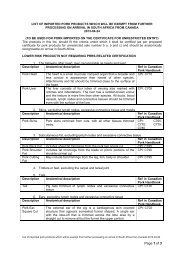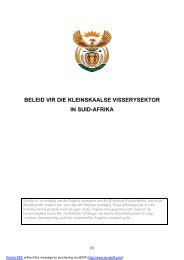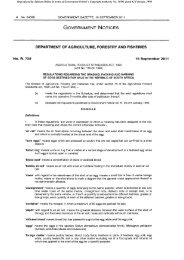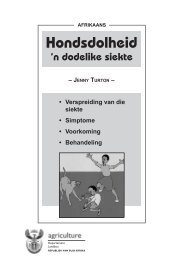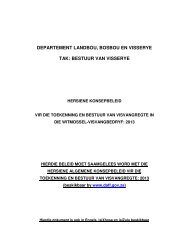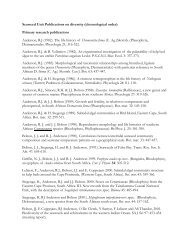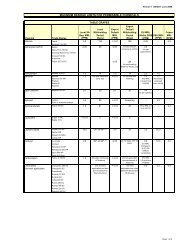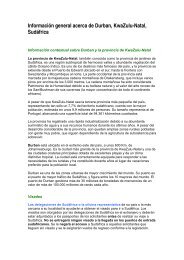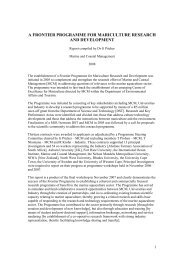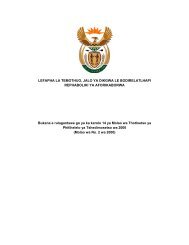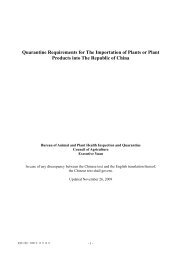Create successful ePaper yourself
Turn your PDF publications into a flip-book with our unique Google optimized e-Paper software.
Whelks are carnivores ‘Whelk’ is a common name for a<br />
large group of snails that have spiral shells with oval openings<br />
(apertures) with a notch or tubular canal. A tube or siphon is<br />
extended through this notch to ‘taste’ the water for<br />
food. Whelks are predators or scavengers and<br />
feed on dead or live animals using a snout-<br />
like proboscis. Whelks mate and then lay<br />
their eggs in capsules. Many whelks use<br />
their tongues to drill holes in the shells of<br />
other molluscs on which they feed. The pustular<br />
triton feeds by secreting acidic saliva down the<br />
tubes of Cape reef worms and then sucks up the<br />
dissolved worms using its long<br />
proboscis. Cones use arrow-like teeth to<br />
inject and paralyse their prey with<br />
venom. Some large species of<br />
cones have toxins potent enough<br />
to kill people.<br />
Subclass Opisthobranchia<br />
– bubble shells, sea hares and nudibranchs<br />
This group includes some of the most beautiful and exotic of<br />
creatures found in the ocean. They are characterised by the<br />
reduction or total loss of the shell. Opisthobranchia means<br />
'back-gills' referring to the situation where, although the larva<br />
becomes twisted (during torsion), the adult untwists again<br />
leaving the gills at the tail end of the slug. In the nudibranchs<br />
the original gills are lost and replaced by feather-<br />
like secondary gills around<br />
the anus or finger-like<br />
projections on the back.<br />
Most species are<br />
gills<br />
specialised predators. They defend themselves by secreting<br />
toxic chemicals or re-using stings derived from their pre y, such<br />
as bluebottles or anemones. Their bright colours and markings<br />
serve as a warning to predators that they are inedible. Opistho-<br />
branchs are hermaphrodites, each individual containing both<br />
male and female sex organs, but they do not self-fertilise their<br />
own eggs. After mating the eggs are laid in jelly-covered<br />
strings or ribbons and hatch into planktonic larvae.<br />
Helmet shell,<br />
a whelk<br />
Cone shell<br />
Nudibranch<br />
Subclass Pulmonata<br />
– land snails, slugs and false limpets<br />
Practically all members of the<br />
Pulmonata inhabit land or fresh<br />
water. Instead of gills their<br />
mantle cavity is lined with blood<br />
vessels and serves as a lung. The only<br />
marine examples are the false limpets, such<br />
as S i p h o n a r i aspecies, which are very common<br />
on intertidal rocks in South Africa. They are cap-<br />
shaped with black and white radial ridges.<br />
The opening to the mantle can be seen<br />
on the right side of the foot. False limpets<br />
can breathe in air using the 'lung' but can<br />
also breathe underwater using<br />
secondary gill-like structures. Siphonarians lay<br />
coiled egg masses in high-tide pools.<br />
The land snail Helix is well known to all gardeners for the<br />
damage it does. It is an alien species introduced from Europe.<br />
Economic Importance<br />
The gastropods include the vast majority of the molluscs and<br />
have an enormous impact on coastal ecosystems as grazers<br />
and predators. There are several economically important<br />
species such as the abalone. Human harvesting of gastro p o d s<br />
for food or to sell the shells can have a detrimental affect on<br />
Classification:<br />
the seashore. There are regulations controlling<br />
the collection of molluscs and sea shells in<br />
South Africa.<br />
PHYLUM: Mollusca<br />
Author: Margo Branch September 2000<br />
CLASS: Gastropoda – Snails and slugs<br />
SUBCLASS: Prosobranchia – Winkles, whelks and limpets<br />
SUBCLASS: Opisthobranchia – Seaslugs and nudibranchs<br />
SUBCLASS: Pulmonata – Land snails, slugs and<br />
false limpets<br />
FURTHER INFORMATION: • Branch, G. M. & Branch M. L. 1981. The Living Shores of Southern Africa. Struik, Cape Town.<br />
• Branch, G. M., Griffiths, C. L., Branch M. L & Beckley, L. E. 1994. Two Oceans: A guide to the marine life of southern Africa, David Philip, Claremont, Cape To w n .<br />
• Branch, M. 1998. Explore the Seashore of South Africa. 2nd edition. Cambridge University Press, Cape Town.<br />
• Kilburn, R. & Rippey, E. 1982. Sea Shells of southern Africa. Macmillan South Africa, Johannesburg.<br />
• Gosliner, T. 1987. Nudibranchs of Southern Africa – a guide to the Opisthobranch Molluscs of southern Africa. Gordon verhof, Seacomber Publications.<br />
RELATED FACTSHEETS: • Sea Shells • <strong>Abalone</strong> • Chitons • Bivalves • Sustainable Use of Coastal Resources • Mariculture<br />
For more information, please contact: The Coastal Management Office, Marine and Coastal Management, Department of Environmental Affairs and Tourism, Private Bag X2,<br />
Roggebaai 8012, Cape Town, South Africa. Tel: +27 (0)21 402-3208 Fax: +27 (0)21 418-2582 e-mail: czm@mcm.wcape.gov.za Website: http://sacoast.wcape.gov. z a<br />
False<br />
limpet





